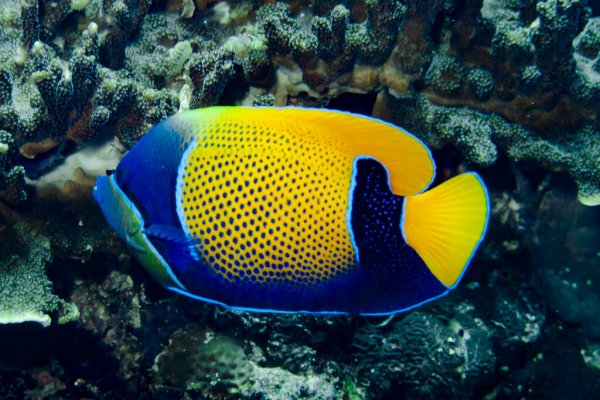ANIMAL: Blue-Girdled/Majestic Angelfish Pomacanthus navarchus Type of Animal: Marine Angelfish Habitat: Coral lagoons, outer coral reefs & slopes, tropical coral reefs, shallow algae-rich inshore caves, coral-rich channels, shallow protected areas, can be found as deep as 131 ft Location(s): Indo-Pacific Appearance: Laterally flattened fish w/ lemon yellow coloration in front of eyes & in frontal area, funnel-shaped deep blue central section, reticulated bright yellow & blue posterior section, yellow flanks, blue mouth/lips, yellow dorsal/tail fins edged w/ pale blue, juveniles dark blue w/ slightly curved lateral stripes Food/Diet: Spirulina, algae, seaweed, nori, sponges, tunicates, zooplankton, shrimp, squid, scallops, clams, vegetable matter, crabs, krill, artemia, cyclops, corals, mussels Status in Wild: Stable Conservation: Breeding in aquaculture & aquariums Lifestyle: Adults found in small harems of a male w/ 1-3 females or alone, juveniles more solitary Additional Info: Called: Male Female Young: Fry Group: School Weight: Male: 16 oz Female: 12-13 oz Gestation: 1 day Life Span: 21 years Body Length: Male: 6.25-10 in Female: 5.25-8 in Young: 2 in Main predators are sharks & larger fish. Also called Navarchus Angelfish. These angelfish are very shy, especially juveniles. Sometimes hybridize w/ closely related Blueface/Yellowface Angelfish. These fish spawn at dusk. During spawning, male quickly swims around female in circular pattern, then swimming above her. Then, female swims towards male, letting him nuzzle her belly to trigger egg-laying. Eggs/sperm released simultaneously into water column. Dorsal/ventral fin lends stability in swimming, tail fin helps it propel through water, & pectoral fins are for locomotion & side-to-side movement. These fish secrete skin mucus providing protection against parasites/infections & helping them move through water faster. One of the smallest Pomacanthus species. Single female can release thousands of eggs each time she mates. Due to not being common in aquarium trade, these fish are highly prized in aquariums, especially for their beauty. They’re rather active fish. Fun Fact(s): These fish extremely difficult to breed in captivity. Like all marine angelfish, these fish born female w/ more dominant/larger females becoming males. This most often occurs when there’s no dominant male around so high-ranking female becomes male. They’ll make drumming/grunting sound when alarmed.
